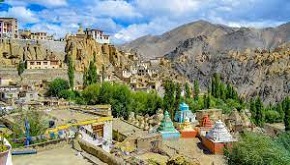
Section 2(e) of the Disaster Management Act 2005 defines a “disaster” as “a catastrophe, mishap, calamity or grave occurrence in any area arising from natural or manmade causes, or by accident or negligence which results in substantial loss of life or human suffering or damage to, and destruction of, property, or damage to, or degradation of, environment, and is of such a nature or magnitude as to be beyond the coping capacity of the community of the affected areas”.
Disaster risk is recognised as the consequence of the interaction between a (or multiply) hazards. Set of prevailing and long term factors, conditions and weaknesses, which adversely affect the characteristics that make people, place and assets vulnerable and exposed.
Mathematically: Disaster Risk = Hazard x Exposure x Vulnerability
The Union Territory of Ladakh is multi-hazard prone area which has required a multi- disciplinary approach to deal with these hazards. Therefore, disaster risk management cycle can be divided in several phases, which required active participation of various stakeholders. A well made plan can involve a continuous and integrated process of planning, organising coordinating and implementing measures that are essential for the different phases of disaster risk management. A well prepared plan envisages the stakeholders with adequate responsibility and role to achieve goal of minimum losses to both life and property. A well prepared plan helps in handling the hazards in such a way that it does not turn into disasters.
The DDMP recognizes the need to reduce, if not eradicate, any ambiguity in the responsibility framework. It therefore, specifies who is responsible for what at different stages of managing disaster. The DDMP is implemented in a scalable manner over all phases of disaster management: (a) Mitigation (Prevention and Risk Reduction), (b) Preparedness, (c) Response and (d) Recovery (immediately restorable to long –term build back better).
The DDMP provides a framework with role clarity for rapid mobilization of resources and effective disaster management by the Central and UT governments and other concerned stakeholders. While focuses primarily on the needs of the government agencies, it envisages all those involved in disaster management including communities and non government agencies as potential stakeholders.